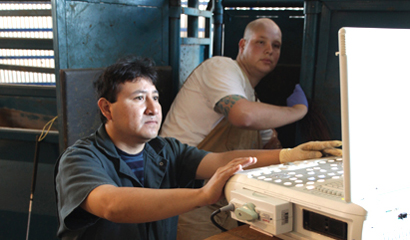
Dr. Manuel Palomino, bison superhero
Palomino as well as his graduate supervisor, WCVM professor Dr. Gregg Adams, are part of a team of researchers who are trying to figure out a way to establish a viable population of disease-free wood bison and ensure their survival in this historical region of Canada.
When you meet Dr. Manuel Palomino of the Western College of Veterinary Medicine (WCVM), it’s hard to imagine the small, five-foot-three Peruvian PhD student in superhero spandex and flowing cape.
Yet to the few thousand wood bison that reside in northern Alberta’s Wood Buffalo National Park, that’s what he is.
After being nearly exterminated at the hands of European settlers roughly two centuries ago, wood bison are being threatened again. But instead of humans being the source, this new threat is coming from two infectious bacterial diseases — brucellosis and tuberculosis (TB).
Palomino’s research focuses on brucellosis which causes abortions, stillbirths, weak calves and reduced milk yield. Although an infected bison’s general health isn’t usually impaired by brucellosis, the disease affects its ability to reproduce. And a population that can’t reproduce is a population that can’t survive.
Palomino as well as his graduate supervisor, WCVM professor Dr. Gregg Adams, are part of a team of researchers who are trying to figure out a way to establish a viable population of disease-free wood bison and ensure their survival in this historical region of Canada.
The team’s research work is receiving support from the Advancing Canadian Agriculture and Agri-Food Program, the World Wildlife Fund, Canada-Saskatchewan Agri-Food Innovation Fund, the N.W.T. government and the Canadian Bison Association
Vaccination is one option for exterminating the disease. “Studies have shown benefits of using vaccinations in controlling the disease, but the problem in wood bison is more practical,” says Palomino, whose work earned him the 2013 Zoetis Animal Health Graduate Student Research Award this fall.
He explains that initiating a vaccination program to combat the disease would be nearly impossible to implement and may be a waste of limited conservation resources as it may not guarantee the extermination of brucellosis in the park: “These are wild animals that are difficult to locate, catch and handle.”
It seems that the only viable method for completely eliminating the disease is removal and repopulation of the infected bison herd. “We are going to have to kill a few [wood bison] to save a lot, but it is the only way,” says Palomino.
So maybe he isn’t a perfect superhero. But Superman destroyed half of Metropolis while fighting Zod before saving the world, right?
Once infected animals are removed and a suitable waiting period has ended, Palomino and the research team can go in and use sophisticated reproductive technologies to grow a new population of wood bison.
Essentially, he’s going to farm bison embryos. “We want to superstimulate the ovaries [of the bison],” explains Palomino.
Normally wood bison only ovulate one egg at a time, but by using specific techniques, Palomino can synchronize multiple bison to ovulate multiple eggs at roughly the same time. He can then artificially inseminate the animals, wait a day for fertilization and then retrieve the embryos using specialized equipment that would make Batman jealous.
Once they’re retrieved, viable embryos are cryogenically frozen so they can be taken at a later date and implanted into suitable surrogate mothers.
Although Palomino’s current study only focuses on establishing an efficient protocol to harvest, retrieve and store embryos, the final aim will be to produce and release disease-free wood bison calves back into the park — a goal the research team is confident that they can achieve based on the successful birth of two calves through embryo transfer in 2011.
Eventually, these disease-free, healthy wood bison will be transported back to Wood Buffalo National Park where they will ensure the continued survival of this historical species.
Palomino may not have his own comic book, but stay tuned — you may be able to read about this superhero’s next adventures in a future issue of Nature.
Brad McKell of Indian Head, Sask., is a second-year veterinary student who participated in the WCVM’s Undergraduate Summer Research and Leadership program in 2013. Article reposted with permission of WCVM Today, news site for the Western College of Veterinary Medicine.

